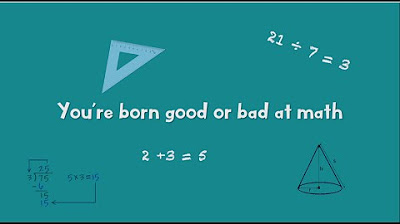Making Mathematical Connections (Maria Quigley)
Summary
TLDRThe speaker emphasizes the importance of making connections in mathematical learning, noting that while educators see links between concepts, students may not naturally do so. By fostering connections, students can better access and remember information. The speaker highlights brainstorming activities, such as associating concepts like triangles, and references guidelines from the National Council of Teachers of Mathematics (NCTM). The talk encourages teachers to explicitly show connections across mathematical topics, stages, and even real-life contexts, improving students' understanding and retention of mathematical ideas.
Takeaways
- 🔗 Connections between mathematical ideas are crucial for students' understanding but are not always obvious to them.
- 🧠 Making connections helps students access and remember mathematical concepts more easily.
- 📚 The National Council of Teachers of Mathematics emphasizes connections as a core part of working mathematically.
- 🔍 Ellen Galinsky describes making connections as an essential life skill, beyond just math.
- 📝 A brainstorming activity can help students identify connections between different mathematical ideas, such as triangles or parabolas.
- 🚸 Teachers should explicitly teach connections in math because students may not automatically make them.
- 🔄 Connections across topics, year groups, and stages help students link current learning to previous and future knowledge.
- 💡 Prior knowledge is important, but students should also be encouraged to link new concepts to other areas of learning.
- ⚖️ Teaching algebra concepts, like distributive law or equations, can benefit from connecting them to basic arithmetic operations.
- 🔺 Geometric topics, like parabolas and special quadrilaterals, offer many opportunities for connecting with other areas of math, such as algebra, ratios, and measurement.
Q & A
What is the main topic discussed in the transcript?
-The main topic discussed in the transcript is the importance of making connections explicit in mathematics education for students.
Why are connections important in learning mathematics?
-Connections are important because they help students access and remember mathematical concepts more easily, as they provide more pathways to the information in their brains.
What is one example of a non-mathematical website that the speaker found relevant to making connections?
-The speaker found a website by Ellen Golinski that discusses life skills, including making connections, which the speaker felt was relevant to mathematical learning.
What activity did the speaker do with students to illustrate connections?
-The speaker had students brainstorm things related to parabolas on a large piece of butcher's paper and then draw lines between the connected ideas.
What are the three elements of making connections mentioned by the National Council of Teachers of Mathematics (NCTM)?
-The three elements are connections among mathematical ideas themselves, across different year groups and topics, and across different stages of learning.
Why did the NCTM include 'connections' as one of the process strands in their principles and standards for school mathematics?
-The NCTM included 'connections' because they saw it as a core idea that is fundamental to working mathematically.
What is the significance of making connections in relation to prior knowledge?
-Making connections is significant in relation to prior knowledge because it helps students link new information to what they already know, which can enhance their understanding and memory of mathematical concepts.
What is one suggestion the speaker gives for helping students make connections with algebra?
-One suggestion is to make explicit the connections between algebraic concepts and arithmetic operations, such as showing that one times x is x before introducing algebraic expressions.
How does the speaker suggest teachers approach teaching quadratics to make connections?
-The speaker suggests teachers look at quadratics within the topic itself, as well as connections to other topics like calculus, to help students see the broader relevance and interconnectedness of mathematical ideas.
What is the purpose of the brainstorming activity mentioned in the transcript?
-The purpose of the brainstorming activity is to get students to become conscious of the many connections between different mathematical concepts and ideas.
What is the speaker's hope for the teachers after discussing the importance of making connections?
-The speaker hopes that teachers will think about how they can help their students make lots of connections in their learning to improve both understanding and memory.
Outlines

このセクションは有料ユーザー限定です。 アクセスするには、アップグレードをお願いします。
今すぐアップグレードMindmap

このセクションは有料ユーザー限定です。 アクセスするには、アップグレードをお願いします。
今すぐアップグレードKeywords

このセクションは有料ユーザー限定です。 アクセスするには、アップグレードをお願いします。
今すぐアップグレードHighlights

このセクションは有料ユーザー限定です。 アクセスするには、アップグレードをお願いします。
今すぐアップグレードTranscripts

このセクションは有料ユーザー限定です。 アクセスするには、アップグレードをお願いします。
今すぐアップグレード5.0 / 5 (0 votes)






